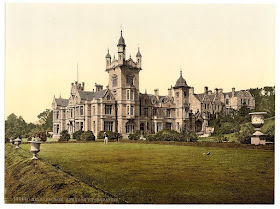The house was soon sold to a Glasgow based syndicate who
intended to turn it into a hydropathic hotel.
Hydros, providing water cures in a luxury hotel, were particularly
popular in Scotland at this time with more than 20 opening in the latter part
of the 19th century. Shandon
Hydro, as it was called, included a heated salt water swimming pool, Turkish
baths, a bowling green, a croquet lawn, a golf course and tennis courts. There was a library full of popular books and
greenhouses provided fresh flowers.
Smoking was strictly forbidden except in the Conservatory.
Safe pleasure boats were provided on the loch and broughams
or landaus could be rented to take visitors on trips to Loch Lomond or Loch
Long. The Hydro proved extremely
popular, until it was requisitioned early in World War One as an experimental
submarine base and naval hospital.
Although restored to its role as a Hotel between the wars, its position
next to the deep sea-loch on the Clyde made it essential to the navy once again
in 1939. Its popularity declined until
it was destroyed in 1957 to make way for the Faslane naval base.







What a sad ending. I hadn't heard of this place before.
ReplyDeleteIt was very near to my birthplace below my family’s farm.
ReplyDeleteHi Liz, I've recently found a couple of slides of the Hydro taken just before its demolition taken by my father. Do you known if there was a salvage operation before it was fully destroyed?
ReplyDeleteIt had reopened as a hotel in 1951 but was not successful so was converted into luxury flats. Presumably they also failed. I can find no evidence of salvage. In the newspaper article I have recording the destruction in September 1957 it states that the building was hard to budge, "Hawsers and tractors pulled and tugged at the tall graceful tower. They were still at it when darkness fell. The foreman said, "We'll leave it for tomorrow boys. The old lady is standing her ground tonight."
DeleteMuch of the stone was used by the local building firm A Trail & Sons to face many of the buildings they built after the demolition. Our own house was a benefactor of much of the beautiful blonde sandstone
DeleteHow lovely to know the history of the stone your house was built with!
DeleteI forgot to ask, what was date and source of the newspaper photo of the demolition in process? It will help me date the slides. Thank you.
ReplyDeleteI don't know the exact date in September 1957 as the newspaper article is looking back on events so is dated 10th January 1969. It is the Helensburgh Advertiser.
ReplyDeleteIn 1955 we moved into the new admiralty houses across the road from Timbacraft boatyard. The houses have now been demolished and replaced by a large block within the Faslane naval base. The Hydro had already been demolished by then. We used to play in the derelict turkish baths, swinging on the ropes.
ReplyDeleteMy cousin used to take me there when I was about 4 or 5. Her boyfriend was the manager for a while
ReplyDeleteMy Grandmother owned the Lodge at the Hydro's driveway entrance. She ran the Post Office and Shop from the Lodge until the late 1960s.
ReplyDeleteI used to visit the Post Office while staying at my grandparents' farm in the late 60s.
Delete